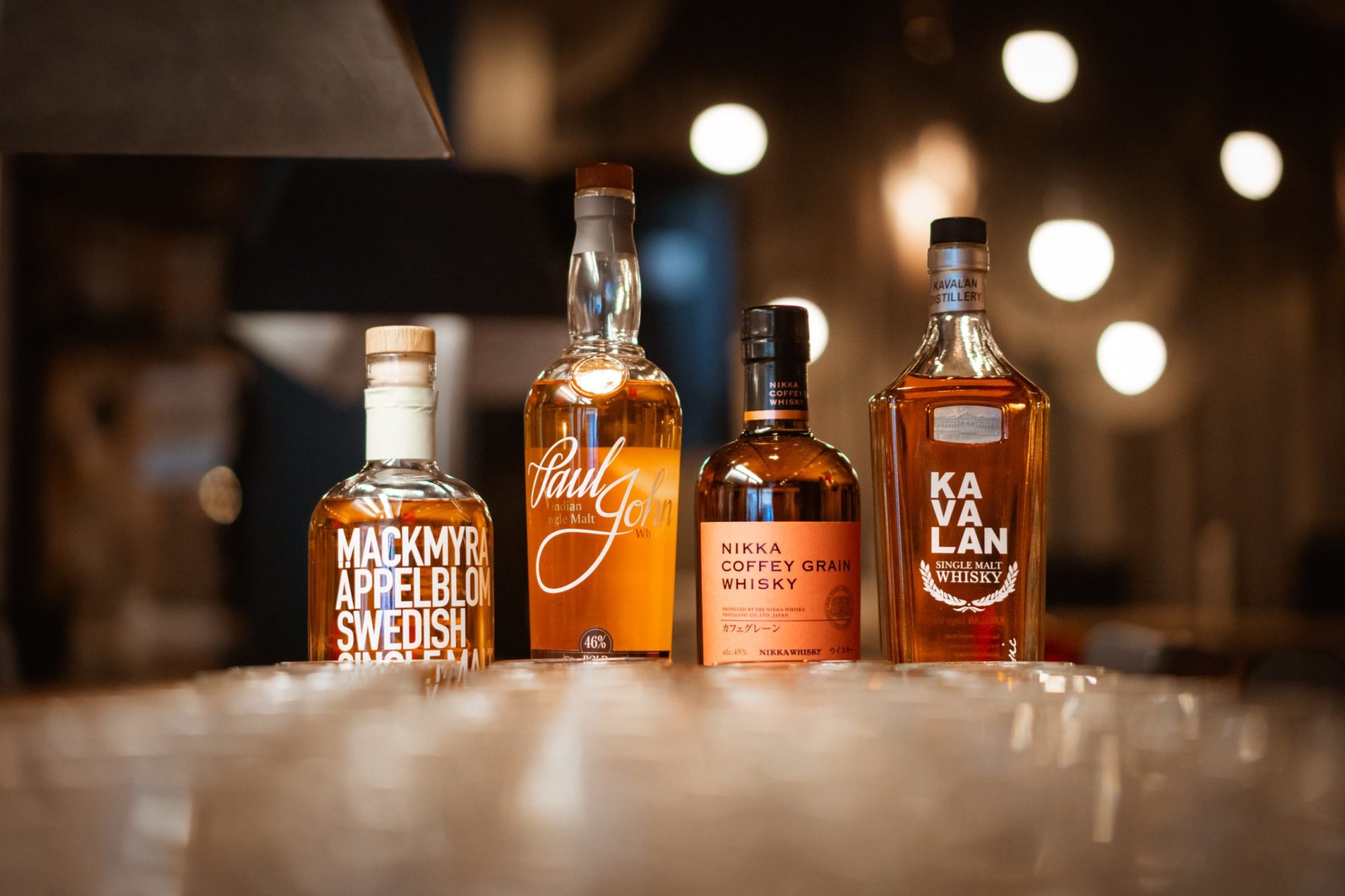World’s Best Whiskies – 5 whisky categories you need to try

Introducing the world’s best whiskies! If you’re a whisky enthusiast or just curious about the world of whisk(e)y, you’re in for a treat. Although the landscape of whisky flavours is ever-changing, and each distillery is almost a world on its own, we can find some guidelines to help you navigate 5 whisky categories you need to try. We have also designed a very informative whisky map highlighting the main whisky-producing countries and the particularities in their process that make each whisky unique.
Whisky, a spirit made from three simple ingredients: water, yeast, and cereals, undergoes a complex process of mashing, fermenting, distilling, and maturing. However, the unique influences of local gastronomy, geography, and culture truly set each whisky apart. These factors, shaped by the industry’s history and developments, have produced marked differences in styles across the main producing countries.
Scotch Whisky
Whisky is Scotland’s flagship drink. The country is the leading producer in the world, with over 145 distilleries on its territory.
Legally, Scotch whisky has to be produced from malted barley (with the optional addition of other grains) and matured in Scotland. It must be aged in oak casks for at least three years, with a minimum ABV of 40%, and no additives other than water and caramel colouring are allowed.
Among the main categories of whisky, we can find Single Malt, made out of 100% malted barley from one distillery (each producing a distinct and individual character). Double distillation in copper pot stills is mainly used, with few exceptions. We then have Single Grain, which allows adding other grains and unmalted barley and is generally distilled in column stills, adding a sweet and spicier character to the spirit. Then we have Blends such as Johnnie Walker, which are made with malt and grain whiskies from different distilleries and are generally smoother and combined to be more palatable.
A flavour distinction can also be found between the different whisky regions in Scotland, although these have to be considered mainly as guidelines as each distillery has its peculiar character.
First, the Lowland whiskies are renowned for their light character and citrusy notes. In contrast, the spirit produced in the Highlands is quite variegated and ranges typically from dry and heathery to sweet and fruity, with occasional smoky hints. Within this region, whiskies from Speyside are a category of their own and tend to be mellow, fruity and malty. The peatiest whiskies are found on Islay, which has a strong coastal influence. Last but not least is Campbeltown, which produces full-bodied, briney whiskies with vanilla hints.
Irish Whiskey

The Emerald Isle is thought to be the birthplace of whiskey. It was one of the primary producers until the late 19th century when the competition against Scotch producers (who introduced the more palatable blends and started buying and closing the distilleries) left the country with only two operative distilleries: Old Bushmills in Northern Ireland and Midleton distillery (Home of Jameson).
However, the Irish industry has been growing since the late 1980s. New distilleries have emerged, bringing new life to traditional styles and embarking on new experimental techniques.
Irish whiskey is generally famous for its smooth, light, and creamy character, mainly attributed to triple distillation. However, it has been made famous by brands such as Jameson and Tullamore Dew (two popular blends).
However, another traditional Irish style is the Single Pot Still, which brings bolder flavours into play. This style, which derives its character from using unmalted barley (at least 30%) in the mash, has a spicier kick and an oily texture, of which Redbreast and Green Spot are good examples.
Finally, the new players on the scene, such as Teeling, are bringing new flavours to the Irish palette with cask experimentations (wine, stout beer and wood variations), with attention to small-batch, grain and single malt production.
American Whiskey

The second biggest whisky producer after Scotland, the United States is home to some of the most iconic brands in the industry.
Unlike Irish whiskey, American drams are regarded as smooth and approachable tipples.
Although the flavour palette is very diverse and the local industry is lively, with producers using various techniques and experimentations, a few main styles dominate the scene.
One of the biggest stars on the flag is undoubtedly Bourbon. This type of whiskey can be made anywhere in the country, but its origins are in Kentucky, which is still home to 95% of the total bourbon production. Its sweetness comes from the fact that it must be made from a mash of at least 51% corn and aged in new, charred oak barrels, giving it the characteristic creamy, vanilla notes and subtle spiciness. No additives are allowed. Jim Beam and Maker’s Mark are among the most famous examples.
A cousin to Bourbon is Tennessee Whiskey, such as Jack Daniel’s, which differs only in the state in which it’s produced and in the use of the Lincoln County Process, namely filtering the new make spirit through a thick layer of maple charcoal to get rid of unwanted flavour compounds and make it a clearer tipple.
Another popular style is Rye Whiskey, where the grain has to make at least 51% of the mash, giving the spirit a rich, full-bodied character with a spicy kick. A 51% wheat-based spirit is the base for Wheat Whiskey, a much softer and gentle tipple.
Stricter rules apply to whiskeys labelled as Straight: they must spend at least two years in new charred oak casks, and if they are less than four years old, the age must be displayed on the label. A variety of blends are also very popular among whiskey drinkers.
Canadian Whisky

Canada has recently returned to the flourishing global whisky scene, but it has a history of popularity dating back to prohibition and is now advancing with its local answers to the small batch movement.
Despite being commonly referred to as “rye”, the predominant grain used is corn. However, other grains such as rye, wheat and sometimes barley are often employed in the production.
The Canadian scene is unique in that it creates whisky through a method of building “blocks”: most local expressions are single distillery blends, where each grain variety is distilled and aged separately to be blended only at the end of the process.
Various stills and cask types are used; however, the more widespread use of triple distillation makes it a generally smooth spirit.
One of the most exciting peculiarities, however, is that the addition of “flavouring” is allowed. This usually consists of a small part (maximum 9%) of wine, sherry, and spirits other than whisky.
Similarly to Scotch, and probably due to the more rigid climate, Canadian whisky must be matured in oak casks for at least three years.
Canadian Club, Crown Royal and Lot 40 are among the most famous brands.
Japanese Whisky

Despite being born less than a century ago, Japan’s whisky industry is now one of the most highly regarded in the world.
This story started thanks to pioneers like Masataka Taketsuru and Shinjiro Torii, who brought the knowledge of distilling from Scotland to Japan and established two of the biggest whisky companies in the country, Nikka and Suntory.
For this reason, Japanese whisky has a lot in common with Scotch; however, its unique cultural background and the demand for fast-paced production have shaped the industry and developed a specific character.
One significant aspect is that each distillery has to rely on its production as, unlike in Scotland, Japanese companies don’t trade in stock among each other. Because of this, distilleries in Japan are a chameleonic breed, and each one is equipped to produce a wide range of styles, from grains to malt, smoky to unpeated, using a variety of fermentation and distillation techniques.
The common thread in the flavour profiles of Japanese whisky is its clear, light character. It often presents fragrant hints of incense, green grass, and the peculiar spiciness of the mizunara casks (Japanese Oak). Still, distilleries such as Yoichi have a smoky, heavier, and oily character and high-quality blends such as Hibiki and Nikka from the barrel are highly praised.
These tasting notes lend themselves to making great mizuwari, a simple highball mixing whisky with ice and water, one of Japan’s most popular ways of enjoying whisky.
Typical brands are Yamazaki, Yoichi, and Chichibu.
Other corners of the world…

Especially in the last two decades, the industry has experienced a considerable revival, which has seen countries worldwide take over the whisky scene and make their name known alongside the “traditional” whisky-making ones.
One of the most notable examples is Indian whisky. The biggest consumer of whisky worldwide, the country’s production has traditionally been dominated by spirits distilled from molasses. However, it has seen its reputation as a producer relaunched thanks to premium-quality brands such as Amrut and Paul John.
One of the most exciting whisky scenes in the Far East is in Taiwan, where Kavalan Distillery has grown to be one of the most renowned names in whisky awards.
Australia is another country experiencing a true boom on its whisky scene, with distilleries taking over in the south, particularly in Tasmania. The whisky here has strong vanilla, apple, and woody flavours. Lark and Sullivans Cove lead the revolution.
Going back North, honourable mention has to go to Sweden, where distilleries such as Mackmyra, Hven and Box are bringing the northern flavours (such as whisky matured in ex-lingonberry wine casks) to the world of whisky.
If you’re not familiar with any of the whiskies mentioned in this article and want to learn more about them, Whisky World offers informative reviews and comparisons with similar whiskies. Check them out!
Conclusion
This list is far from exhaustive, as incredible projects are being developed in all corners of this planet (South Africa, France, Argentina, and many more). As the whisky world expands, new productions are surging in climates and latitudes that are very different from the historical lands of whisky, bringing their unique flavours to the game. One thing is sure: these thriving developments make it an exciting time to travel around the whisky world.
Finally, fancy learning more about whisky and exploring this fascinating industry even further? Check out our blog post about How to taste whisky at home? We believe it is an educational experiment you would love to put into practice.

